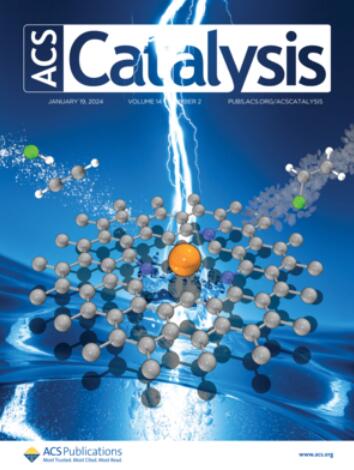Boosting the C–C Coupling Efficiency for Diluted CO2 Electroreduction to Dual Carbon Products
IF 11.3
1区 化学
Q1 CHEMISTRY, PHYSICAL
引用次数: 0
Abstract
Direct reduction of low–concentration CO2 in flue gas to multicarbon products has attracted increasing attention recently since it could reduce the high energy consumption of CO2 purification during CO2 recycling. Although various electrodes have been developed to convert diluted CO2 to different products, the changes in mechanisms due to the reduction of the CO2 concentration have rarely been studied. In this work, defective boron-modified copper electrodes were obtained for the direct conversion of diluted CO2 to dual carbon (C2) products. The Faradaic efficiency of C2 reached as high as 54.9%, even when the CO2 concentration was reduced to 25%. More importantly, the C–C coupling efficiency of *CO intermediates reached up to 79.3% under the condition of 25% CO2. This was attributed to the fact that a small amount of CO2 did not fully occupy all of the active sites at the beginning, which provided possible reaction space for the subsequent coupling and protonation reaction processes. Through in situ monitoring of different reaction intermediates under the conditions of different CO2 concentrations using in situ FT–IR, it is found that decreasing CO2 concentration did not alter the reaction pathway but influenced the conversion rate of key intermediates, which resulted in a change of product selectivity.

提高稀释CO2电还原双碳产物的C-C耦合效率
将烟气中的低浓度二氧化碳直接还原为多碳产品,可以减少二氧化碳回收过程中二氧化碳净化的高能耗,近年来受到越来越多的关注。虽然已经开发了各种电极来将稀释的CO2转化为不同的产物,但由于CO2浓度降低而引起的机制变化很少被研究。在这项工作中,获得了用于将稀释的CO2直接转化为双碳(C2)产品的缺陷硼修饰铜电极。当CO2浓度降至25%时,C2的法拉第效率仍高达54.9%。更重要的是,在25% CO2浓度条件下,*CO中间体的C-C偶联效率高达79.3%。这是由于少量的CO2在开始时并没有完全占据所有的活性位点,从而为后续的偶联和质子化反应过程提供了可能的反应空间。利用原位FT-IR对不同CO2浓度条件下的不同反应中间体进行现场监测,发现降低CO2浓度不会改变反应途径,但会影响关键中间体的转化率,从而导致产物选择性的变化。
本文章由计算机程序翻译,如有差异,请以英文原文为准。
求助全文
约1分钟内获得全文
求助全文
来源期刊

ACS Catalysis
CHEMISTRY, PHYSICAL-
CiteScore
20.80
自引率
6.20%
发文量
1253
审稿时长
1.5 months
期刊介绍:
ACS Catalysis is an esteemed journal that publishes original research in the fields of heterogeneous catalysis, molecular catalysis, and biocatalysis. It offers broad coverage across diverse areas such as life sciences, organometallics and synthesis, photochemistry and electrochemistry, drug discovery and synthesis, materials science, environmental protection, polymer discovery and synthesis, and energy and fuels.
The scope of the journal is to showcase innovative work in various aspects of catalysis. This includes new reactions and novel synthetic approaches utilizing known catalysts, the discovery or modification of new catalysts, elucidation of catalytic mechanisms through cutting-edge investigations, practical enhancements of existing processes, as well as conceptual advances in the field. Contributions to ACS Catalysis can encompass both experimental and theoretical research focused on catalytic molecules, macromolecules, and materials that exhibit catalytic turnover.
 求助内容:
求助内容: 应助结果提醒方式:
应助结果提醒方式:


